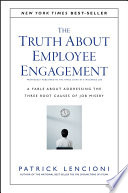

Employee engagement is a critical factor in organizational success. The book defines employee engagement as the level of commitment and involvement an employee has towards their organization and its values. It emphasizes that engaged employees are more productive, deliver better customer service, and contribute to a positive workplace culture. The author argues that traditional metrics for measuring engagement, such as employee satisfaction surveys, often fail to capture the true essence of engagement. Instead, organizations should focus on fostering a sense of purpose, belonging, and connection among employees to drive engagement. This idea highlights the need for leaders to develop a deep understanding of what truly motivates their employees beyond superficial perks.
Continue readingLeadership plays a pivotal role in shaping employee engagement. The book discusses how leaders who are transparent, communicative, and empathetic can create an environment where employees feel valued and heard. It emphasizes that effective leaders should not only set clear expectations but also provide the necessary support and resources for employees to thrive. The author argues that leadership should be more about serving employees rather than commanding them. This shift in perspective encourages leaders to focus on building trust and cultivating a culture of open dialogue, which in turn enhances employee morale and engagement.
Continue readingOrganizational culture is a significant determinant of employee engagement. The book explains that a positive culture fosters engagement by aligning the organization's values with those of its employees. It discusses how organizations can create a culture of engagement by promoting inclusivity, recognizing achievements, and encouraging collaboration. The author stresses that culture is not just about perks or benefits; it is about creating an environment where employees feel a sense of belonging and purpose. A strong culture can lead to higher retention rates, improved performance, and a more robust organizational identity.
Continue readingFeedback and recognition are essential components of employee engagement. The book highlights that employees crave feedback on their performance and want to be recognized for their contributions. It discusses the importance of creating a feedback-rich environment where continuous communication is encouraged. The author suggests that organizations should implement regular check-ins, performance reviews, and recognition programs to acknowledge employee efforts. This idea emphasizes that recognition does not have to be extravagant; simple acknowledgments can significantly boost morale and reinforce engagement.
Continue readingThe book presents a strong correlation between employee engagement and organizational performance. It argues that engaged employees are more likely to go above and beyond in their roles, leading to increased productivity, better customer experiences, and ultimately, improved financial performance. The author supports this idea with research and case studies that demonstrate how organizations with high levels of engagement outperform their competitors. This connection underscores the importance of prioritizing engagement initiatives as a strategic business objective.
Continue readingEmployee well-being is a critical factor in fostering engagement. The book discusses how organizations that prioritize the physical, mental, and emotional well-being of their employees can enhance engagement levels. It emphasizes the need for companies to implement wellness programs, promote work-life balance, and provide mental health resources. The author argues that when employees feel supported in their well-being, they are more likely to be engaged and committed to their work. This idea highlights the holistic approach organizations must take to address the needs of their workforce.
Continue readingThe book concludes with the idea that employee engagement is not a one-time initiative but a continuous journey. The author stresses that organizations must consistently assess and adapt their engagement strategies to meet the evolving needs of their employees. This idea encourages leaders to view engagement as an ongoing process that requires regular evaluation, feedback, and adjustment. By adopting this mindset, organizations can create a sustainable culture of engagement that evolves with their workforce and industry changes.
Continue reading